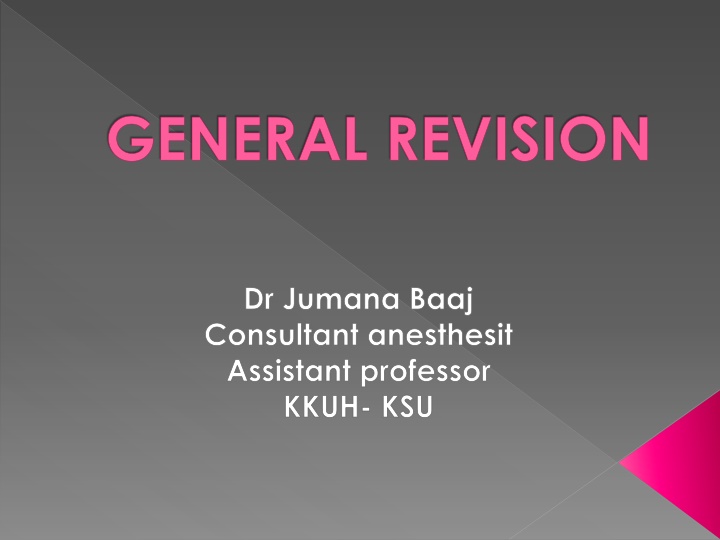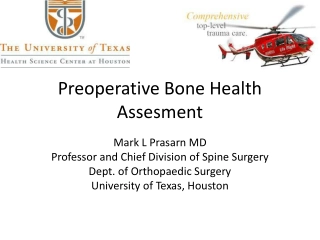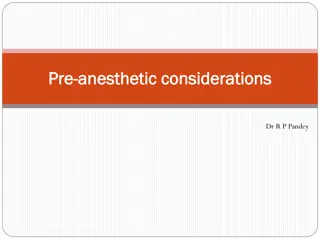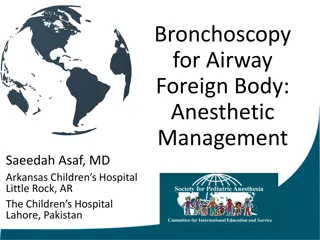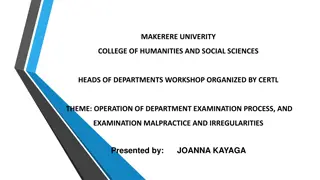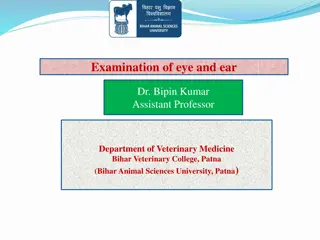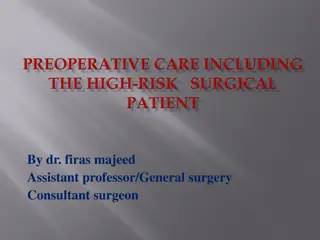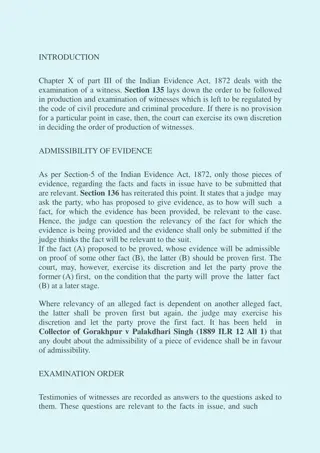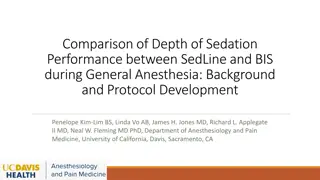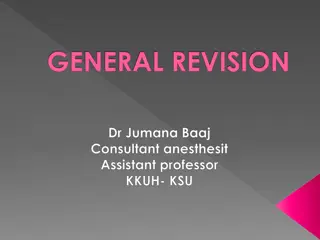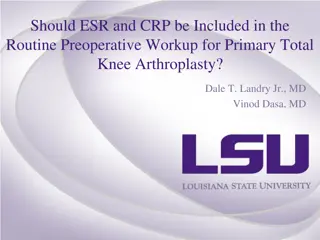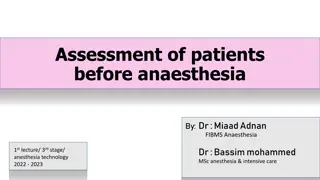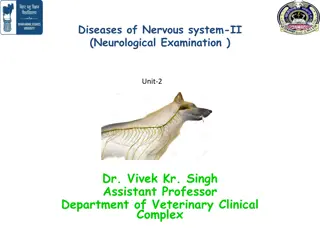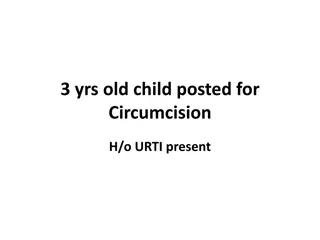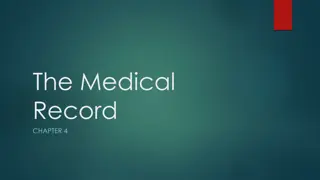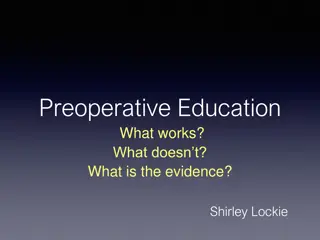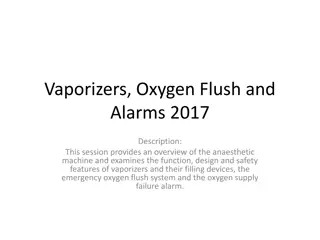Role of Anaesthetist in Preoperative Care: History, Examination, and Anesthetic Options
Anaesthetists play a crucial role in preoperative care by obtaining patient history, conducting physical examinations, and assessing anesthetic options based on patient co-morbidities and surgical procedures. They also manage airways, administer general anaesthesia, and perform regional anaesthesia techniques. This comprehensive guide covers key aspects of an anaesthetist's role including airway management, general anaesthesia techniques, and spinal anaesthesia protocols.
Download Presentation

Please find below an Image/Link to download the presentation.
The content on the website is provided AS IS for your information and personal use only. It may not be sold, licensed, or shared on other websites without obtaining consent from the author.If you encounter any issues during the download, it is possible that the publisher has removed the file from their server.
You are allowed to download the files provided on this website for personal or commercial use, subject to the condition that they are used lawfully. All files are the property of their respective owners.
The content on the website is provided AS IS for your information and personal use only. It may not be sold, licensed, or shared on other websites without obtaining consent from the author.
E N D
Presentation Transcript
GENERAL REVISION Dr Jumana Baaj Consultant anesthesit Assistant professor KKUH- KSU
Role of anaesthetist in the preoperative care Lecture a) Obtain a full history and physical examination including allergies, current medications, past anesthetic history, family anesthetic history b) The medical student will understand how patient co- morbidities can affect the anesthetic plan. c) The medical student will be able to understand potential anesthetic options for a given surgical procedure.
General anaesthesia technique a) Definition of general Anaesthesia b) Learn about several agents used on induction of general anaesthesia including intravenous agents, inhalation agents, neuromuscular blocking agents and reversal agents. c) Understand basic advantages and disadvantages of these agents. d) Complications commonly encountered during general anaesthesia
Airway Management and equipment a) Learn about basic airway anatomy b) Conduct a preoperative airway assessment c) Identify a potentially difficult airway d) Understand the issues around aspiration and its prevention e) Learn about the management of airway obstruction f) Become familiar with airway equipment g) Practice airway management skills including bag and mask ventilation, laryngeal mask insertion, endotracheal intubation h) Learn about controlled ventilation and become familiar with ventilatory parameters i) Appreciate the different ways of monitoring oxygenation and ventilation
RegionalAnaesthesia Techniques a) What are the risks and benefits of regional (epidural/spinal) anesthesia/analgesia? b) What are the contraindications to regional anesthesia? c) How do you prevent hypotension following epidural/spinal anesthesia?
Spinal Anaesthesia a) Describe the technique of spinal anesthesia. b) At what level does the adult spinal cord end? c) Name some of the surgical procedures that can be done with a spinal anesthetic. d) What are the contraindications to spinal anesthesia? e) What are the complications? f) Describe the patient's perception as spinal anesthetic takes effect. g) What are the expected cardiovascular changes associated with sensory level at T10? T1? h) How do you treat post-lumbar puncture headache?
Epidural Anaesthesia a) Discuss the differences between spinal and epidural anesthesia. b) What are the advantages and disadvantages of epidural compared to spinal anesthesia? c) Study the size and tip of the epidural needle. d) Name some of the surgical procedures that can be done with an epidural anesthetic. e) What role does epidural has for post-operative pain control? f) Local Anesthetics Pharmacology and toxicity (Lidocaine, Bupivacaine
Case senareo A 26 year old male patient is admitted to the emergency department diagnosed to have perforated appendix for urgent emergency appendectomy . last meal 2hours ago. Vital signs: BP 120/70mm Hg and HR 90/min.Chest The patient was previously healthy . PE: patient currently look ill. and CVS normal .last meal 1hours ago
Professional behavior Introduce your self , -Greeting the patient , -Take permission to examine her . -Explain to the patient what you will do . -don t be tough , no misbehavior.
What is your preoperative assessment Anesthesia plan
Preoperative assessment 1 history age present illness drugs allergies past history (operations and anaesthetics) anaesthetic family history social (smoking, alcohol) 2 examination airway teeth general examination 3 specific assessment 4 investigations 5 consent 6 premedication
The patient was previously healthy . PE: patient currently look ill. and CVS normal last meal 2hours ago Surgical Hx : no previous Hx - Allergy Hx .:not known to have any allergy . - Family history :not significant . - Review investigation :all within normal range .
Airway Evaluation Oropharyngeal visualization Mallampati Score Sitting position, protrude tongue, don t say AHH
Airway assessment Take very seriously history of prior difficult intubation difficulty Short immobile neck Full set of teeth, buck teeth High arch palate Poor mouth opening less than three fingers gap between upper and lower teeth Receding mandible (may be hidden by a beard) Inability to sublux the jaw (forward protrusion of the lower incisors beyond the upper incisors)
- ModifiedMallampati scoring system Grade 1: faucial pillars, soft palate and uvula visible Grade 2: faucial pillars, soft palate visible, but uvula masked by the base of the tongue Grade 3: soft palate and hard palate only visible Grade 4: hard palate not visible Head and neck movement Flexion and extension are greater than 90 in normal people. - Jaw movement and mandible Check that the patient s mouth opens normally. It should have an interincisor gap of greater than 5 cm(about three finger breadths) Thyromental distance if the distance is more than 6.5 cm,problems should not occur with intubation. Other tests Indirect laryngoscopy and various x-ray procedures are occasionally used.
Example A 80 years old patient booked for TURP under spinal anesthesia
What I should expect from you Performance Steps correctly Taking Consent from the patient Assessment (indications and contraindications) Connect monitors SPO2, ETCO2, ECG , non invasive blood pressure Start iv fluids Mask, cap, gown and gloves Prepare the back with antiseptic Place a sterile Drape Over The Area Identify the anatomical landmarks Inject local anaesthetic into the skin and deeper tissue Insert the large introducer needle into the selected spinal interspace Direct the spinal needle through the introducer and into the subarachnoid space Free flow of CSF confirms proper placement Aspirate for CSF if clear inject the proper anaesthetic Remove the needle, introducer and drape sheet Have the patient lie down
Example 39 years old patient booked for emergency CS due to fetal distress How you will manage ?
What I should expect from you 1.Preoxygenate with 100% oxygen by non-rebreather mask for at least 3 full, deep breaths. Preoxygenate four minutes if situation allows. 2. Administer propofol OR etomidate. 3. Apply cricoid pressure and hold until patient has been intubated, balloon of ETT has been inflated, position of tube tip has been assured, and ETT has been secured in place. 5. Administer succinylcholine 1 mg/kg IVP (100 mg for average 70kg patient) and wait for paralysis to occur. 6. Intubate. 7. When successfully intubated, confirm placement by a. Bilateral breath sounds, and b. Chest wall rise, and c. Absense of gastric sounds, and d. End tidal CO measurement, and 8. fixed
Anesthesia OSCE The exam with be 5 stations, with clinical scenarios in each station. Objectives: Pre-operative assessment. (General and anesthesia specific questions) Airway examination. Malampati classification Atlanto-occipital joint extension Thyro-mental distance X-ray Prolonged apnea *IMP* Anesthesia Complication:
Anesthesia Complication: (tachycardia bradicardia- hypoxia- hypercapnia .) Common instruments , Name the instrument Uses , Complications Central venous cannula Epidural Spinal How to induce a pt. Pain will not be included in the OCSE Know your ABC , and start with it if you were asked about the management .
